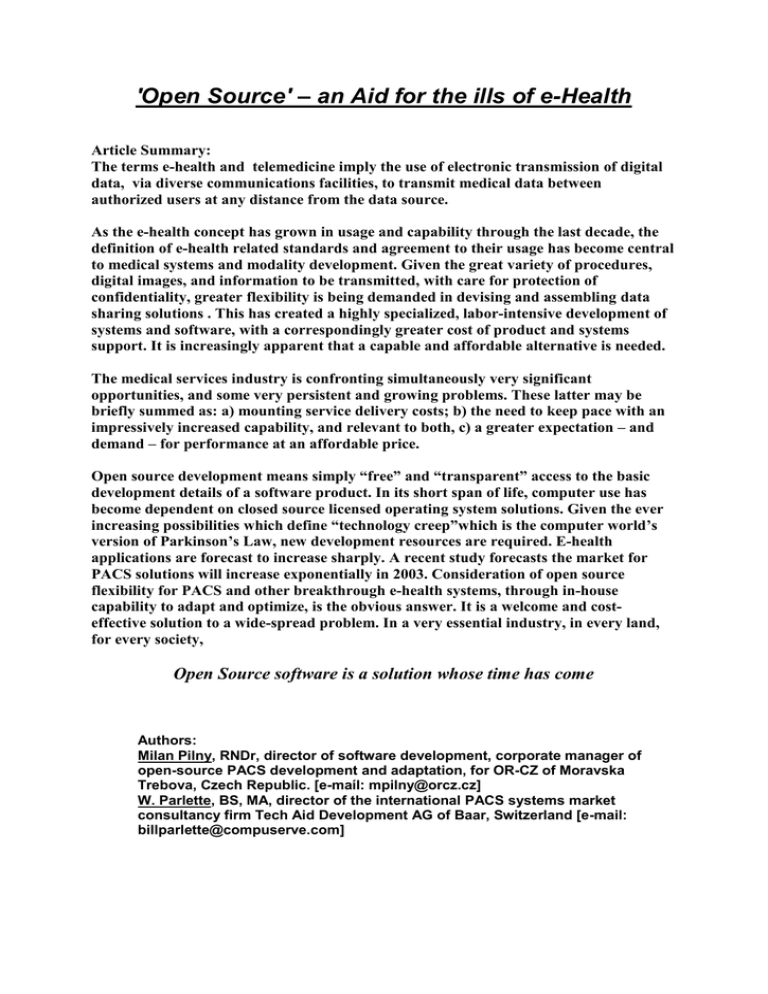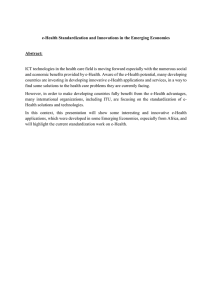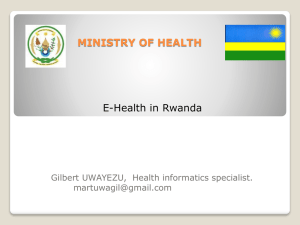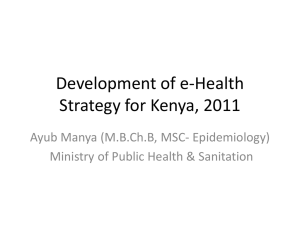– an Aid for the ills of e-Health 'Open Source'
advertisement

'Open Source' – an Aid for the ills of e-Health Article Summary: The terms e-health and telemedicine imply the use of electronic transmission of digital data, via diverse communications facilities, to transmit medical data between authorized users at any distance from the data source. As the e-health concept has grown in usage and capability through the last decade, the definition of e-health related standards and agreement to their usage has become central to medical systems and modality development. Given the great variety of procedures, digital images, and information to be transmitted, with care for protection of confidentiality, greater flexibility is being demanded in devising and assembling data sharing solutions . This has created a highly specialized, labor-intensive development of systems and software, with a correspondingly greater cost of product and systems support. It is increasingly apparent that a capable and affordable alternative is needed. The medical services industry is confronting simultaneously very significant opportunities, and some very persistent and growing problems. These latter may be briefly summed as: a) mounting service delivery costs; b) the need to keep pace with an impressively increased capability, and relevant to both, c) a greater expectation – and demand – for performance at an affordable price. Open source development means simply “free” and “transparent” access to the basic development details of a software product. In its short span of life, computer use has become dependent on closed source licensed operating system solutions. Given the ever increasing possibilities which define “technology creep”which is the computer world’s version of Parkinson’s Law, new development resources are required. E-health applications are forecast to increase sharply. A recent study forecasts the market for PACS solutions will increase exponentially in 2003. Consideration of open source flexibility for PACS and other breakthrough e-health systems, through in-house capability to adapt and optimize, is the obvious answer. It is a welcome and costeffective solution to a wide-spread problem. In a very essential industry, in every land, for every society, Open Source software is a solution whose time has come Authors: Milan Pilny, RNDr, director of software development, corporate manager of open-source PACS development and adaptation, for OR-CZ of Moravska Trebova, Czech Republic. [e-maíl: mpilny@orcz.cz] W. Parlette, BS, MA, director of the international PACS systems market consultancy firm Tech Aid Development AG of Baar, Switzerland [e-mail: billparlette@compuserve.com] 'Open Source' – an aid for the ills of e-Health OK, what are we talking about here? Fundamentally, the term “open source” relative to software development refers to software that comes with the source code in a form that the customer can modify, to customize or upgrade for his own needs, and resell or give away to other users under the same terms. The trade organization Software in the Public Interest has registered the phrase "open source" as a certification mark. The web site http://www.opensource.org/ contains a detailed definition of just what open source means. Other groups have trade-marked similar terms. A number of industry standard software licenses are consistent with the general meaning of open source. Simply put, open source software is customer constructed software, which adheres to internationally accepted open source development standards. You are encouraged to check out these web references. So why should I be interested? Well, there are significant advantages from use of open source standards which are of special interest to the e-health industry … not the least of which is cost. For example: 1. Lower software costs: specifically for initial capitalization, support, and update. 2. Greater flexibility in software modification enabling “adapted` design. 3. A remarkably high degree of reliability. Bob Young, president of RedHat software, has compared buying proprietary software to buying a car with the engine compartment welded shut. Peer reviews and widespread testing of experimental builds during the open source development process have proven to result in final products that are more reliable than their commercial closed-source counterparts. In the event of problems, having the source code available and modifiable enables the root cause to be isolated and fixed. We all know the alternative with “closed” software: re-install the software and tinker with the controls and see if the symptoms go away. Or consult the vendor, often for a fee, to fix the problem when there is time enough. 4. The user is not “captive” to a single hardware or software vendor, permitting the most cost-effective selection of hardware modalities and software performance. 5. Increasingly rapid innovation fueled by a general industry focus on economy AND performance. Etc. Well, every pro has a con; what are the risks of open source? Open source methods, like all software development methods, do not guarantee success. The key technical prerequisites for success are the skills and dedication of the core system designers and project interface developers. Even in the circumstance of an open source project developed but not successfully employed, there is left a legacy of source code and ideas that can be merged into more successful subsequent efforts, or contribute to successful other projects. It is not wasted energy. And why have we heard relatively little about open source ‘til now? The simple answer: there was little early commercial interest because of a minimal prospect for profit. Open source software has been available “from the beginning” [e.g. Unix and derivations, now including the increasingly popular Linux], and has grown in scope in the interval. Microsoft in the meanwhile, capitalized on an early control of the DOS (disk operating system) design, and with considerable managerial and technical skill enabled a data processing boom, with a diversity of applications which benefited us all … and especially Microsoft, through the profitability of their follow-on succession of Windows products. The remarkable success of the PC – remember, the “P” means Personal - was founded on individual and small business use. These are users accustomed to popular, relatively uncomplicated closed-source solutions, who ared not particularly concerned about the speed or versatility of the operating system … as long as it works [!] Until recently the trade press and relevant market research organizations have not evaluated open source alternatives, again for economic reasons … the general market interest has not been there. However, data processing professionals working for large corporations frequently have UNIX experience, and are familiar with a wide range of open source software solutions. As the use of the PC spread rapidly also through industrial installations which connected PC users in world-wide networks, especially the remarkable internet, the economics of individual PC licensing demand a hard look, and the view is toward open source. Can I trust my business to open source software If you do business via the Internet, you already do. The “Key” infrastructure of the Internet, e.g. domain name lookup and e-mail forwarding, is done largely with open source software. Many Internet service providers and some of the most active sites on the web are hosted on open source operating systems. The question might be better phrased “can your business profitability afford to ignore open source?” . So where are we today …? Not surprisingly, the first successes of open source software have been in areas where the user and developer are one and the same person. The origins of open source have been through developers with unsolved problems and frustrated desires who then wrote code for their own use, often in their spare time, subsequently to share the results, motivated by economy to themselves in a reciprocal cooperation. Users of open source software fund its development directly, either by working on the software themselves, or contracting with someone else to do it. This is the key to its success, and highlights why it is revolutionizing the software industry. Economics…. The best known symbols of open source success are noted here: Linux is the only operating system outside the Microsoft Windows family with a growing market share. According to press reports quoting IDC and Datapro studies (2000), Linux was already then used by more than 14% of USA businesses. This number has grown very significantly in the interval to 2003. Netscape Navigator is now an open source product. Netscape has seen the commercial and profit advantages of open source. Apache is the number one web server in use. Apache development is partially supported by IBM. The Internet itself: one of its great strengths is its open source character, which has resulted in the unexpected phenomenon of no-cost use. The incredible proliferation of net creativity and imagination is all by itself response to “Why Open Source?” GNU compilers and other development tools are now the standard tools on many platforms. FreeBSD, NetBSD and OpenBSD are the foundation of many ISP businesses and major web services such as Yahoo. The Perl language is the basis for much of the active content on web pages. O'Reilly & Associates, Inc. support work on Perl.. What do all these curious terms mean? Give some examples: A typical internet application working with data can have three basic parts: e.g. Database,. Application server, and Application client, under the operating system (OS); Database – is storage for data, for a free open source application in this case we can use for database creation and access the database query language mySQL. ( www.mysql.com ) Application server – it communicates with the database, caching and working with its data. The data is then prepared for useful employment, usually that of viewing. To work with the data we can use JavaBeans and for preparing data for viewing we can use Java Server Pages (JSP) technology based on the java platform (www.java.com). JSP and JavaBeans are inserted into the open project container Tomcat (jakarta.apache.org/tomcat) closely harmonized with the http server Apache (jakarta.apache.org). Client server – which communicates with the http server Apache, and displays data via the monitor screen. To access and display the data, we can use open source based Netscape Navigator (www.netscape.com/netscape). Operating system – which coordinates all this activity, is more and more likely to be Linux (www.linux.org), for the excellent and important reason of costeffectiveness. I’m glad I asked … how about drawing me a picture? Apache mySQL SQL Tomcat JavaBeans JavaServerPages http Netscape Navigator The graphic basic design example above shows but one way of portraying how the data flows from storage to user. Be aware that JavaBeans and JSP are also both defined as open source , creating a complete chain of open source links from data source to user. In such a system, there is no need to pay licensing fees any part of this basic software. Well, OK…. Why is open source of special interest to e-health? Cost concerns, flexibility, reliability, the same general advantages we noted above…. The present lively interest in combining Hospital Information (HIS) and Picture Archiving and Retrieval Systems (PACS) recognizes its potential to offer tremendously useful health care service delivery advantages. Data and Image handling efficiency translates directly into labor and time savings, significantly reducing costs. And a simpler, open source PACS system ensures further cost savings by standardizing system and storage hardware, which can be expanded as more viewing stations come on line without having to pay additional license costs. Open source means the ability easily to interface “foreign” modalities, e.g. any lesser known brand of new equipment, or older, perhaps re-conditioned DICOM standard compatible legacy devices. This is a consideration of special importance to less affluent markets as in the so-called third world, where tele-medicine is the only reasonable solution to health services delivery, in a world of relatively few physicians and technicians, and diagnostic centers are few and scattered away from the bulk of the population in remote areas. [Information and/or reference lists about the open source mini-PACS system MARIE (Medical Archiving and Retrieval of Images Electronically) which has been so successful in the USA and Canadian health care markets, maybe be obtained via the e-mail address of either author of this article.] Let’s get down to the basics: what does open source cost? The simple answer: whatever your budget will allow. If the customer organization decides to download open source code, to customize it for unique needs, to compile and test in-house binary coding on each platform of interest, to install it on each machine, to print their own manuals and provide their own user training and support, these open source software tools are "free". Cost?: employee and contract labor. And support? Small companies and non-technical users need ad hoc service and basic support by out-sourcing. Open source software is also sold in traditional packages by commercial companies which offer paper manuals, CD-ROMs ,and telephone support, at prices generally much more economical than competitive proprietary software vendors. There are many options available at affordable costs, Cost?: remote support contract fees, communication facilities Large corporations need all of these services and can chose to do them in-house or by contract. Since the source is open, they have a broad choice of contractors and resellers to chose from and complete flexibility to change anything to meet their most exacting needs. Cost?: employee and contract labor, remote support costs The freedom from licensing costs (per machine, per user, per connection) enables rapid deployment of applications and their modifications, and flexible reconfiguration without budget surprises. From this point of view, open source is very useful for, and should be very attractive to third world and emerging state economies. What are some e-health care-specific open source resources? www.oshca.org – Open Source Health Care Alliance (OSHCA). OSHCA is a collaborative professional grouping formed to promote and facilitate open source software usage in human and veterinary healthcare. www.openhealth.com – these pages have very large index of openhealth projects based on open source software. Conclusion Open source is a relatively new phenomenon in the development of e-Health cost effective software. As it is presently experienced, developmental cooperation has seen the creation of development teams whose members are scattered around whole world, connected via internet. Applications may be produced by independent remote groups which can do localization of software to conform with local language custom needs, and to be able to provide technical and programmer support in the local market. When technical and operational standards are defined and adhered to over a broad spectrum of users, the industry benefits. And when open source standards are added to other standards already in place, the benefits translate directly to flexibility, reliability, and manageable costs. [Information about any technical organization or product referenced in this article maybe be obtained via the given web address, or via the-mail address of either author of this article.]





